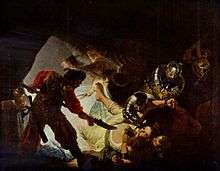Blinding (punishment)

Blinding is a type of physical punishment which results in complete or nearly complete loss of vision. It has been used as an act of vengeance and torture.[1]
The method has been known since Antiquity. The Greek mythology makes several references to blinding as divine punishment, which reflects human practice. An example is Oedipus, who gouged out his own eyes after accidentally fulfilling the prophecy that he would end up killing his father and marrying his mother.[2] In the Bible, Samson was blinded upon his capture by the Philistines.[3]
Early Christians were often blinded as a penalty for their beliefs.[4] For example, St. Lucy's torturers tore out her eyes. In the Middle Ages, blinding was used as a penalty for treachery or as a means of rendering a political opponent unable to rule and lead an army in war.[5] In the 11th century, William the Conqueror used blinding as a punishment for rebellion to replace the death penalty in his laws for England. Henry I of England blinded William, Count of Mortain, who had fought against him at Tinchebray in 1106. He also ordered blinding and castration as a punishment for thieves.[5] In 1014, the Byzantine emperor Basil II had 99 of every 100 captured Bulgarians blinded, leaving 150 one-eyed men to lead them back to their commander.[1] Blinding was accomplished by gouging out the eyes, sometimes using a hot poker, and by pouring a boiling substance, such as vinegar, on them.[6]
Blinding survives as a form of penalty in the modern era, especially as part of the sharia law. In 2003, a Pakistani court sentenced a man to be blinded after he subjected his fiancee to an acid attack resulting in loss of vision. The same sentence was given by an Iranian court in 2009 for a man who blinded Ameneh Bahrami in an acid attack; Bahrami eventually pardoned the attacker.[1]
See also
References
- 1 2 3 Goes, Frank Joseph (2013). The Eye in History. JP Medical Ltd. p. 234. ISBN 9350902745.
- ↑ Rose, Martha L. (2003). The Staff of Oedipus: Transforming Disability in Ancient Greece. University of Michigan Press. pp. 81–82. ISBN 0472113399.
- ↑ Hartsock, Chad (2008). Sight and Blindness in Luke-Acts: The Use of Physical Features in Characterization. Brill. p. 107. ISBN 9004165355.
- ↑ Pearman, Tory Vandeventer (2010). Women and Disability in Medieval Literature. Palgrave Macmillan. p. 89. ISBN 0230117562.
- 1 2 Evans, Michael (2007). The Death of Kings: Royal Deaths in Medieval England. A&C Black. pp. 37, 89–90. ISBN 1852855851.
- ↑ Lawler, Jennifer (2004). Encyclopedia of the Byzantine Empire. McFarland. p. 106. ISBN 1476609292.